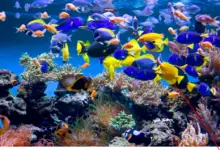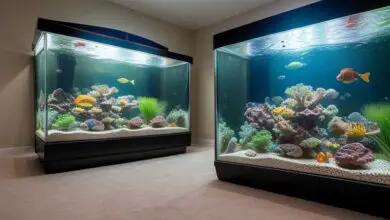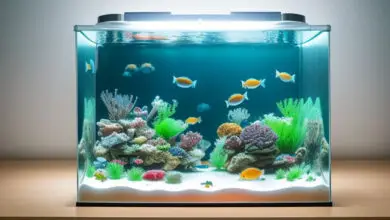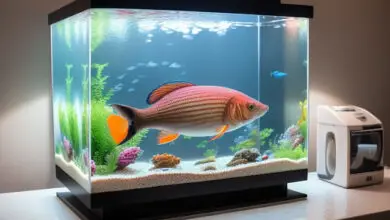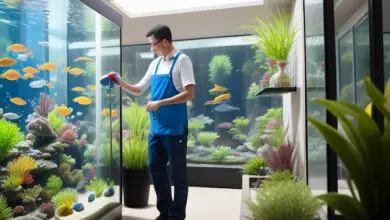25 Green Aquarium Supplies & Decor to Create a Beautiful Underwater World

More and more fish enthusiasts are looking for ways to create healthy underwater environments while also reducing their environmental impact.
In this blog post, we will look at 25 eco-friendly aquarium supplies and decor ideas to help you design a naturally beautiful tank that you can feel good about.
Natural Rocks & Driftwood
Decorating your aquarium with products sourced straight from nature is a fabulous way to add beauty and interest while skipping the carbon emissions and waste of manufactured alternatives.
River Rocks
River rocks make for superb hardscape materials to create rock structures, caves, ledges, and overhangs for your fish. Look for rocks with smooth surfaces and interesting shapes that have been tumbled over time by flowing water. Arrange them to make little hideaways and territories that bring intrigue to your layout.
The neutral earth tones of river rocks blended with lush green plants result in very natural-looking aquascapes. And unlike artificially colored gravel or resin ornaments, they won’t fade or leach chemicals over time.
Cholla Wood
Cholla is a very porous wood that makes an ideal surface for beneficial bacteria to colonize. With its intricate branch patterns, cholla wood adds visual dimensionality to tank spaces. It also leaches tannins said to mimic the natural environment of many tropical fish.
Position cholla wood strategically to create shaded areas, territorial markers, and obstacles for fish to swim around. Over time, a layer of algae will grow on the surface, helping it truly blend into its surroundings. Being a natural material, the wood may float when first submerged, so pre-soak it and use substrate or rocks to keep it in place until waterlogged.
Mopani Wood
In addition to its aesthetic beauty, mopani wood releases tannins and slowly softens water over time in a tank. Its leathery texture becomes covered in microscopic critters, creating an authentic biotope to sustain fry and small species.
Search for mopani root pieces with lots of nooks and crannies to function as hideouts and spawning sites. Interesting bark textures and wood grain patterns add nice visual dynamics too.
Locally Collected Rocks & Driftwood
For the most eco-friendly tank decor, look no further than your own backyard! Select rounded river bed rocks, weathered branches, and dried leaves from nature spaces near you.
Just be very choosy, only gathering items you’re certain have not been chemically treated or exposed to pollution that could leach toxins into your aquarium. And always make completely sure you’re not taking anything illegally or damaging the environment.
When it comes to rocks and driftwood for your tank, think natural, local, and sustainable! Their authentic textures and colors lend organic beauty while saving on manufacturing and transport resources.
Live Aquarium Plants
Live plants are practically a must for any eco-conscious aquarist! They naturally filter water, provide shelter, release oxygen, moderate pH levels, and bring vibrancy to tank environments.
Easy Care Species
When first venturing into live flora for your aquascape, go with these low maintenance varieties that even newbies can grow successfully:
- Java Fern: Hardy, adaptable plants that thrive attached to rocks, wood, and decorations. They propagate quickly too!
- **Anubias: **With broad leaf shapes that make shady hiding spots, these species grow slowly and require very little care.
- Cryptocorynes: Add nice green foundation foliage at tank bottoms, perfect for foreground accents and contrast.
- Moss Balls: Actually a colony of algae, these interesting spheres don’t need to be planted, just rolled wherever you want green accent spots!
Stem Plants
Long twisting stems that can be planted in bunches create jungles of vegetation if given adequate tank conditions. Try these striking varieties:
- Hornwort: Fast growing stems with thin pine-like foliage to give height and volume.
- Anacharis: Flowing bunches of narrow leaves make the perfect natural backdrop.
Floating Plants
Plants like hornwort, anacharis, and other stems with buoyant foliage also make fantastic floating accents at the water’s surface. For plants specifically evolved to float, go with:
- Duckweed: Tiny leaves that rapidly spread across the surface, providing overhead coverage.
- Water Lettuce: Fluffy textured rosettes create scattered lily pad effects.
- Frogbit: Trailing roots that dangle in the water column give added dimension.
No matter which live plants you choose, they’ll boost water quality without electricity while accenting your tank with natural beauty!
Natural Aquarium Gravel & Sand
Choosing all-natural substrates sourced from the earth itself brings sustainability to your tank flooring while adding nice color contrasts against green growing things.
River Gravel
Composed of smoothed pebbles and rocks, river gravel creates a charmingly rustic ground cover that’s gentle on most fish species’ barbels and fins. The tan and brown neutral earth tones accent planted tanks beautifully.
To encourage healthy root growth while avoiding toxic air pockets, use grain sizes from 0.5 to 2cm blended together and slope gently from front to back. This allows detritus to collect at the lower levels where it’s easier to siphon away.
Play Sand
Nothing could be more natural than sand! For a super fine-grained substrate, choose play sand varieties that have been sterilized and packaged for safety.
Tan and white play sands result in cloudy reflections that lend an authentic riverbed biotope aesthetic. Use at least 2 inches deep to allow room for rooted plants. Choose peaceful community fish that won’t disturb clouds into the water column.
Black Diamond Blasting Sand
This specialty sand offered by industrial suppliers is actually crushed black granite. Inert, non-toxic, and affordable, it adds wonderful brightness and contrasts to planted freshwater tanks.
Themini obsidian-like grains sparkle brilliantly and make red and green plants really stand out. Rinse extremely thoroughly before use and go with a finer sand grain size for delicate rooted species.
Energy Efficient Equipment
Cut electrical costs while saving natural resources by choosing energy efficient aquarium gear designed specifically for low wattage operation.
LED Aquarium Lights
Modern LED light panels and hanging fixtures specially engineered for aquarium use are extremely electricity efficient compared to traditional fluorescent bulbs. They produce little heat while emitting wavelengths beneficial for photosynthesis in live plants.
Many LED options come with wireless remotes and programmable timers. This allows customizing intense midday bursts and slowly dimming intensities to simulate natural daylight fluctuations.
Going with LED means skipping toxins like mercury found in standard bulbs. The solid state epoxy encased design typically lasts over 50,000 hours too. Less waste, lower energy draw, and longer lasting definitely equals a greener way to brighten up your underwater world!
Circulation Pumps & Powerheads
Eco-friendly choices are also available when it comes to water flow equipment. Circulation pumps and powerheads typically run 24/7, making their electricity use add up substantially over time.
New Energy Star certified models offered by various brands are engineered specifically for low wattage operation. Flow rates are slower than standard pumps but still fully adequate to reduce dead spots and evenly distribute heat, nutrients and waste.
For additional energy savings during nighttime hours when photosynthesis stops, connect pumps to an outlet timer to turn off overnight. Just be sure flow reductions won’t impact critical life support systems if used on sensitive reef or fry grow out systems.
Non-Toxic Water Care
Saltwater aquarists have pioneered sensitive reef safe water testing and supplement products that are also beneficial in freshwater planted tanks. Here are some great options for non-toxic system maintenance:
Liquid Test Kits
Many old-school test strips and tablets contain nasty heavy metal reagents that get rinsed into tank water. Seeking out non-toxic liquid test kits is an easy green switch to make!
For example, API’s Freshwater Master Kit uses safe colorimetric liquid reagents with clearly labeled bottles that last hundreds of tests. Red Sea’s pro kits feature an eco-friendly refill pouch to drastically reduce plastic waste compared to most competitors.
Green Water Supplements
Green aquarists can also find suitable chemical additives for water balance that are reef safe and natural. Two great examples are Seachem’s Flourish Excel and Brightwell Aquatics’ Microbacter7. Both contain gluconic acids derived from plants and helpful probiotic microbes.
When added with regular water changes, non-toxic supplements like these reduce the need for harsh algaecides and antibiotics that pollute closed systems. They keep fish healthy while protecting delicate live plants and biofilter bacteria too.
Sustainable Aquarium Foods
Even feeding your fish and inverts can be done the green way. Seek out quality foods that skip filler, artificial colors and cruel harvesting methods. Here are some great options:
Omega One Frozen Formulas
This company built their reputation formulating reef-safe mixes with the highest quality nutrition. Their color-enhancing frozen foods use garden-raised earthworms, shrimp, and plankton rich marine cubes.
Available in blister packs instead of plastic tubs, Omega One’s frozen items reduce waste and thaw quickly. Feed a few cubes 2-3 times a week to supplement flake or pellet meals.
New Life Spectrum Pellets
With formulas optimized specifically for popular tropical species, New Life Spectrum is a fantastic option for daily fish feeds. Made in small batches and naturally color-enhancing, the floating pellets mix well with frozen or freeze dried items.
The tiny size works well for juveniles and prevents water fouling since most gets eaten immediately. Pick their “Green” formula with added spirulina and kelp for picky plant-eating types like tetras, barbs and livebearers.
Eco-Friendly Maintenance Tools
Cleaning and aquascaping tools specifically designed with sustainability in mind help reduce plastic waste and work fabulously. Here are some top examples:
Penn Plax Green Algae Scrubbers
Penn Plax’s popular Magnet algae cleaning combos feature scrub pad holders molded from biodegradable wheat straw instead of oil-based plastic. Safe for glass and acrylic tanks, the inner magnet allows scrubbing in hard to reach spots to keep viewing panes clear.
Reduce microplastic pollution in your aquarium while effectively removing unsightly algae buildup! It’s a win-win sustainable switch from typical scrub pads and brushes. These innovative accessories make aquarium care much greener.
Python No Spill Clean N’ Fill Syphons
Python revolutionized water changes forever when they invented the No Spill Clean system decades ago. Save hours every week simply siphoning old tank water out to the garden or lawn while refilling straight from the tap without buckets!
The thick flexible tubing lasts for years while skipping heavy lifting, and adjustable flow-through adapters prevent back siphon contamination. By streamlining the process Pythons reduce the temptation to skip needed water swaps for convenience and cut 5 gallon bucket plastic waste dramatically.
Biodegradable Accessories
Plastic pollution is a huge issue affecting oceans worldwide. By selecting accessories made from plant cellulose instead of oil-based plastic polymers, hobbyists keep waste out of watersheds and landfills.
San Francisco Bay Brand Nets
This eco-brand uses 100% natural wood pulp and cotton to fabricate nets, breeder boxes and reflecting backgrounds. Fine micro mesh basket nets provide gentle control for moving shrimplets or catching newborn fry.
Best of all when these accessories eventually wear out they’re fully compostable if compositing facilities exist locally. Otherwise they degrade naturally just like leaf litter without leaching toxins into soil or water supplies.
Penn Plax Pearl Grass Spawning Mops
Penn Plax makes substrate mop spawning aids from sustainable PEAT moss instead of environmentally damaging plastic fibers. The natural grass-like strands encourage egg scattering species like tetras, rasboras and danios.
With proper conditioning the 100% biodegradable mops can be reused for multiple spawn cycles. When ready to retire a mop, simply compost or incorporate into a garden without worry. The peat moss material will break down naturally over a season.
Final Sustainable Shopping Tips
By choosing all-natural decor, live plants, efficient equipment, quality foods and biodegradable accessories, freshwater aquarists can feel proud creating beautiful balanced tanks sustainably.
Here are some final tips for green shopping success:
- Seek out small specialty local fish stores in your area to find many of these items while supporting local businesses and avoiding big retailer waste and transport emissions.
- Check manufacturer websites for sustainability initiatives when deciding between brands. Many now offer recycled packaging, eco-friendly ingredient sourcing and transparency reports.
- Consider used equipment through hobbyist forums and apps like OfferUp. Rehoming functional filters, pumps and lights saves them from landfills. And gently used accessories mean skipping new manufacturing pollution.
- Select regional foods, plants and dry goods to reduce transport miles and support suppliers in your bioregion when possible. Thoughglobal commerce makes many exotic items like driftwood and certain fish species accessible too.
Most importantly, spread the word so sustainable aquarium keeping becomes more mainstream! Together fishkeepers can make the hobby greener for the next generation

